This is your ultimate guide to bento box Lunch! Whether you’re making school lunches for your little ones or work lunches for yourself, this guide will help you plan and pack a healthy and colorful bento. Plenty of tips and tools for you to get started.
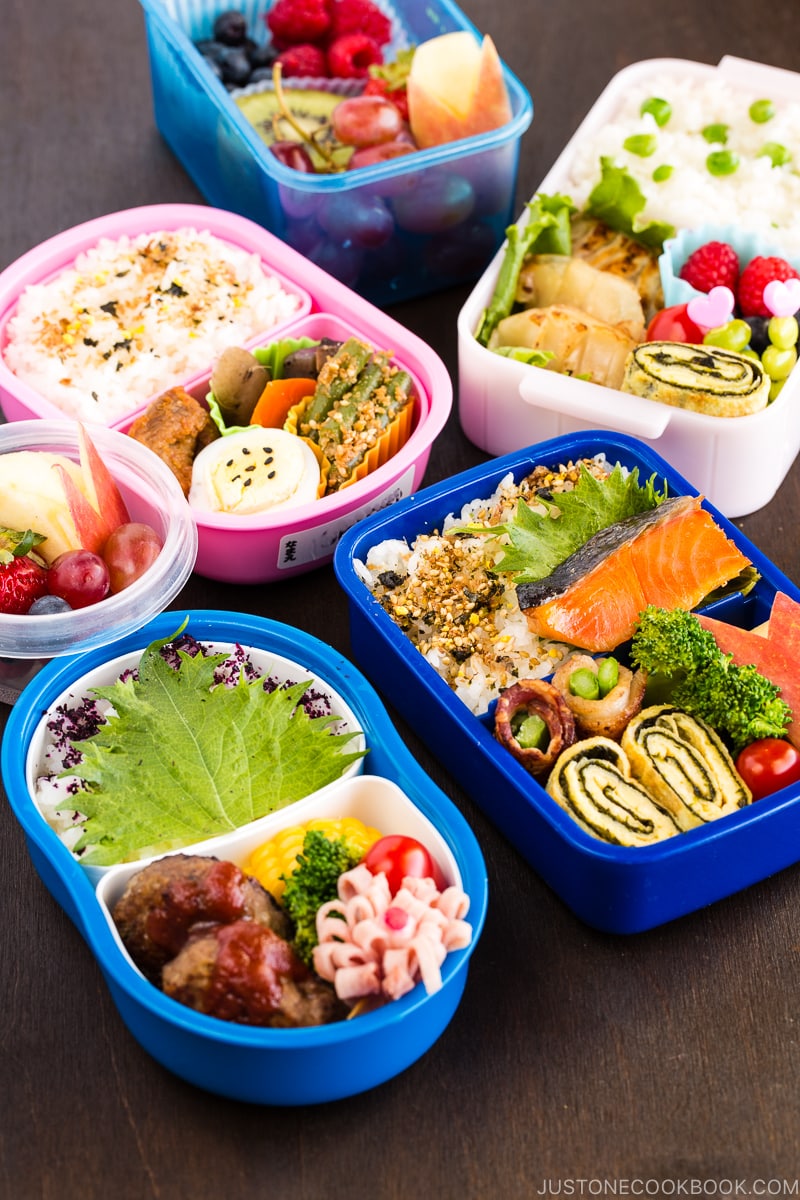
These days, bento boxes have become synonymous with lunch boxes. I have seen so many wonderful bento lunch boxes filled with all kinds of food – from American comfort food, Tex-Mex, Indian, Italian to fusion – and it makes me really happy that the bento culture has gone global.
As a Japanese mother, packing bento boxes for my two children is the ultimate act of love. And I believe it is the same no matter your background. In this post, I will share how I make bentos for my children.
Table of Contents
What is Bento?
In Japanese, bento (弁当 bentō) or obento (お弁当 obentō) refers to a compact, nutritiously balanced, visually appealing meal served in a box. We call the bento container “bento-bako” (弁当箱).
Did you know that Japanese bentos are meant to be eaten at room temperature? Because of it, we slightly modified the way we prepare food for bento. Examples include:
- The food tends to be more heavily seasoned with salt or sauce when prepared for bento so it tastes better at room temperature.
- Avoid dishes that may not taste good at room temperature such as Japanese Curry and very fatty meats like pork belly slices. If the food cools and a lot of fat solidifies, it’s not ideal for bento.
- Deep-fried food is reheated in the toaster oven in the morning and allowed to cool completely before being packed into the lunch box. Deep-fried food such as karaage, tempura, and wings are very popular on bento menus and are enjoyed even at room temperature.
Why Should We Make Bento?
There are some great benefits to bringing a bento to school or the office.
- Healthy – If you follow the rule of thumb for bento packing, you naturally have a good portion of carbs, proteins, vegetables, and fruits in your lunch box. As the bento comes in compartmentalized containers, they serve as a helpful reminder of the portion sizes for your meal.
- Economical – Bringing food, or even leftovers, from home is always more economical than spending money at restaurants. In another words, it will save you a lot of money!
- Eco-Friendly – Bento boxes are reusable, which means you can reduce the amount of plastic bags, disposable containers, and waste.
Chapter 1: Bento Boxes and Accessories
In this chapter, we’ll go over different bento box options and helpful tools for bento making.
1. Bento Boxes (Lunch Boxes)
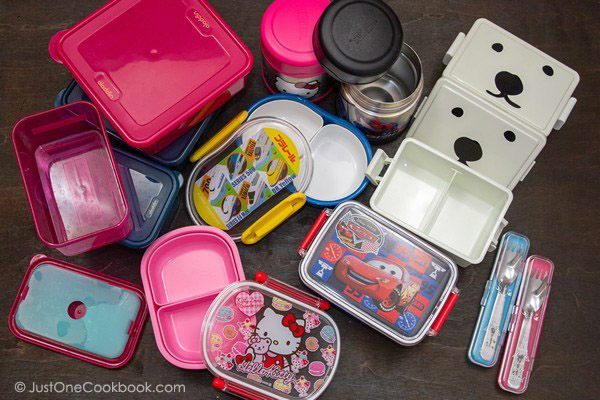
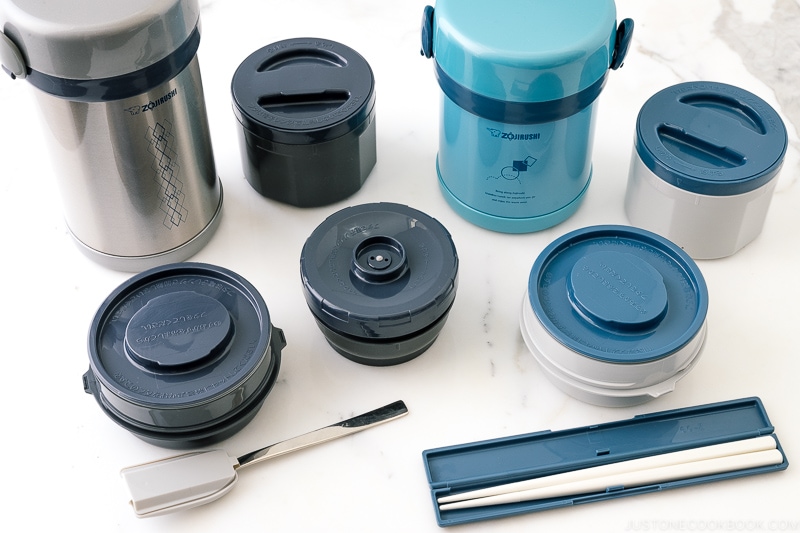
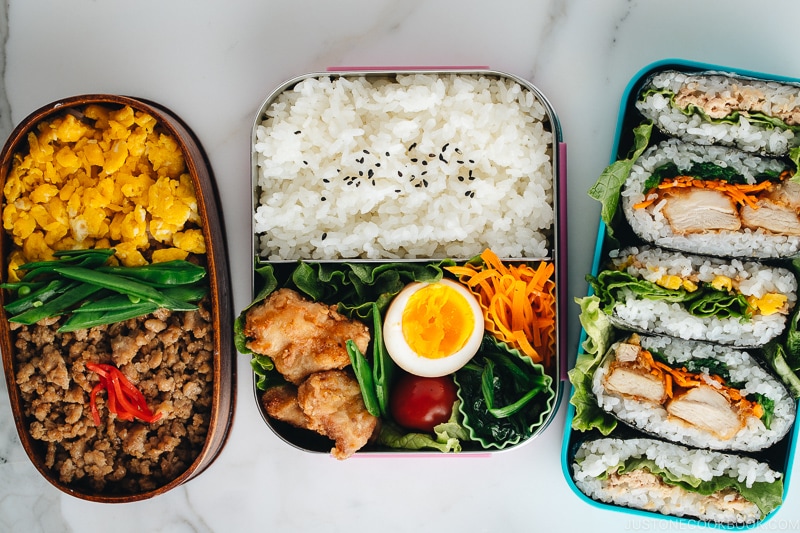
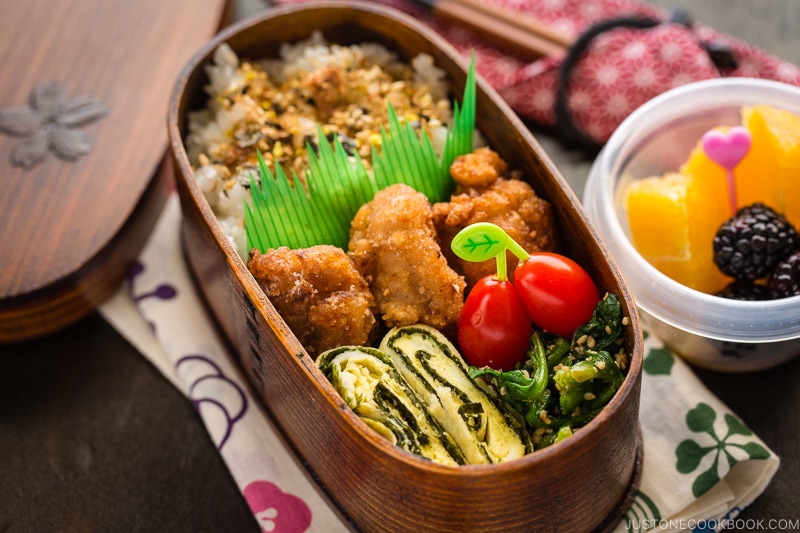
It doesn’t have to be a Japanese bento box. You will need some sort of container or lunch box to put your food in. I use thermal lunch boxes for warm food like pasta and grilled cheese sandwiches.
- Japanese character lunch boxes: I brought them back from Japan but you can probably find some on Amazon or online. Bento&Co sells a variety of bento boxes and ships internationally.
- Thermal food jars: I used them for hot food like pasta and grilled cheese sandwiches. After trying several jars over the years, I think Zojirushi jars keep the food warmer than Thermos.
- Zojirushi lunch jars: Kids have used Ms. Bento® Stainless Lunch Jar SL-MEE07 (2 inner bowls) and Ms. Bento® Stainless Lunch Jar SL-NCE09 (3 inner bowls) until they became too busy to eat a full lunch during a short lunch break.
- Stainless steel lunch boxes: Kids still use these Lunchbots containers to bring sandwiches.
- Utensil sets: The sets like this and this are pretty convenient.
- Magewappa (曲げわっぱ): I do not use these wooden bento boxes for my children, but the traditional wooden box makes it a popular choice among adults. You can get it on Amazon and Bento&Co.
2. Bento Accessories
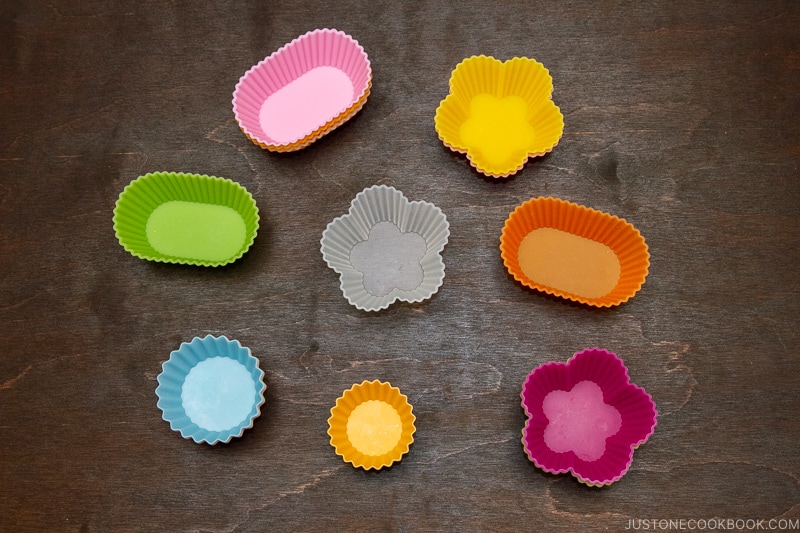
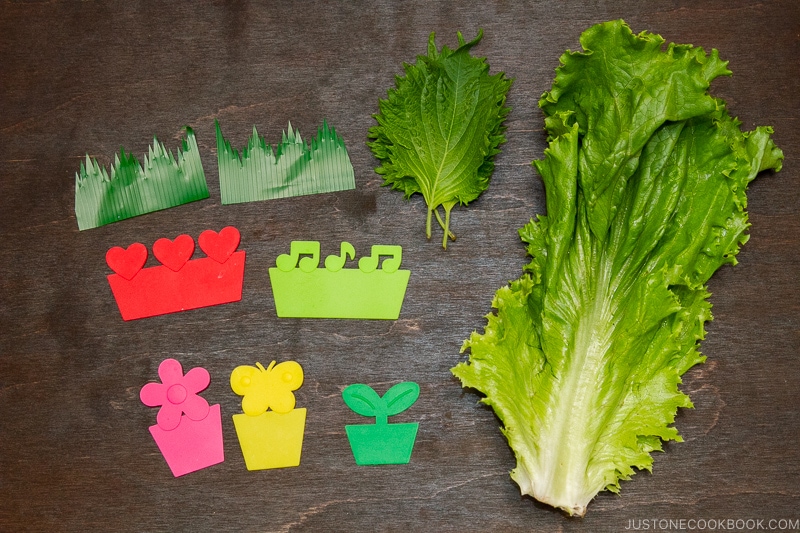
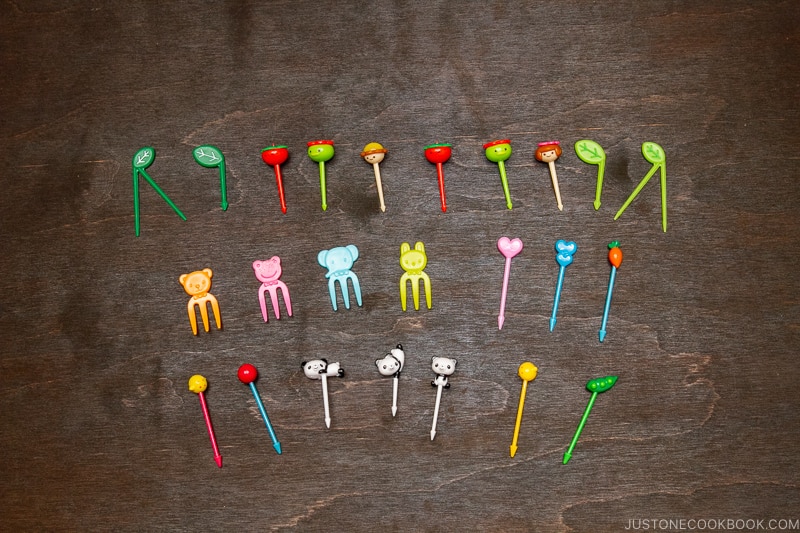
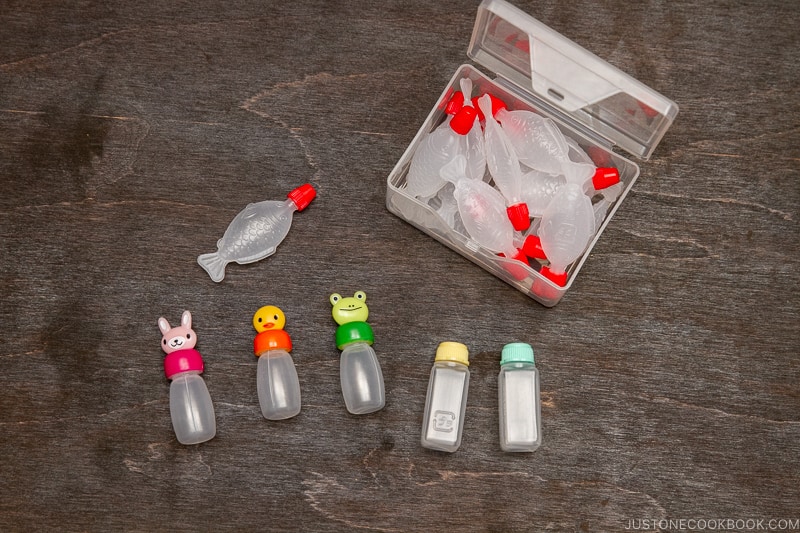
- Silicone cups: The silicone cups are great for keeping wet things away from dry foods and holding loose items like blueberries in one place. Usually, silicone cups come in bright and cheerful colors, which improve the presentation of the bento. They are reusable and come in many different sizes and colors.
- Dividers: The silicone dividers come in bright colors to improve the presentation for the bento and they help separate one food from the other without mixing up the flavors. You can also use edible separators such as lettuce, shiso leaves, cucumber slices, etc.
- Food picks: These picks come in many shapes, patterns, and colors and some are really playful and cute (like my little panda picks)! They are helpful to put small foods together (like meatballs and berries) and also add extra color to your bento. Children are gravitated to eating foods with those picks.
- Sauce containers: The sauce containers help you store the sauce separately so that the food will stay dry until lunchtime. It’s not so pleasant when the sauce ends up getting mixed with foods it’s not meant for.
- After trying different containers, I prefer jar-style containers like this and this with a twist lid so it’s easy to wash.
- For those who prefer a cute soy sauce container, here are animal containers and fish-shaped containers.
Chapter 2: Plan Bento Menus
First, use your creativity to visualize how a bento should look. Bento making doesn’t have to be complicated, and you can start with simple dishes that you are familiar with.
Since I mostly cook Japanese food at home, I mainly focus on packing Japanese dishes.
Tip #1: Prepare 5 Types of Foods
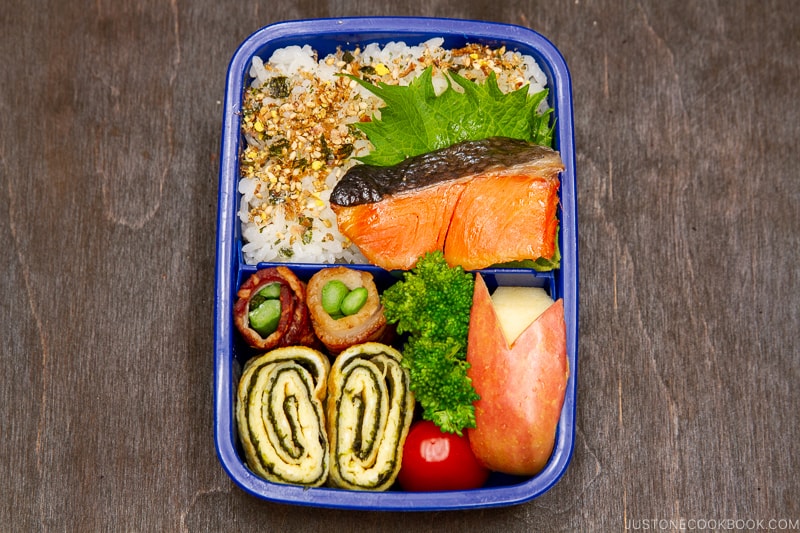
For a Japanese-style bento, we commonly include 5 types of food in the lunch box:
- Carb – Fill up tummy! (rice, yakisoba, yaki udon, fried rice, or mixed rice like the classic takikomi gohan or Japanese corn rice)
- Main (Protein)– Meat, fish, and seafood (karaage, gyoza, bulgogi, teriyaki salmon)
- Sides (Vegetables) – Also, tofu, egg, or mushroom dishes (potato salad, tamagoyaki, green bean gomaae)
- Fillers – Simple yet colorful ingredients to brighten the bento (edamame, blanched broccoli, cherry tomatoes, boiled egg)
- Fruits – In the bento box or in a separate container (berries, grapes, apples)
This will help you assemble a nutritiously balanced meal.
Tip #2: Keep Rainbow Colors in Mind
When making choices about which foods to include in the bento box, choose bold colors to provide visual impact. Echoing doctors’ advice to ‘eat your colors’, colorful vegetables and fruits are often high in nutrients.
If I have similarly colored dishes like broccoli and asparagus, I separate them and place other foods in between to make the bento more visually appealing. Sprinkling colorful furikake (rice seasonings) or garnishing with chopped parsley and green onion adds a nice accent to the overall presentation.
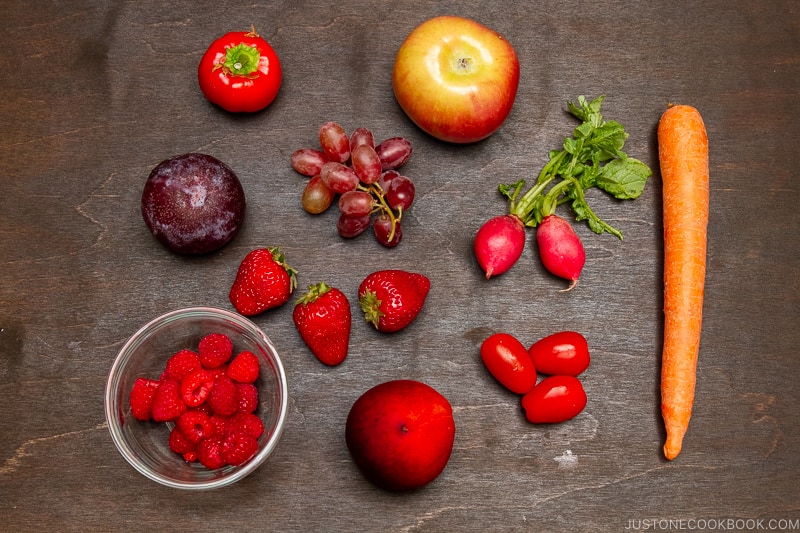
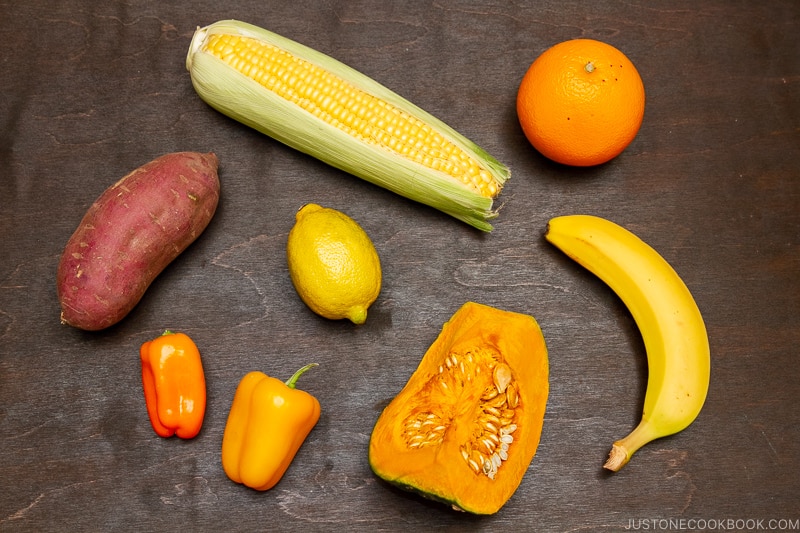
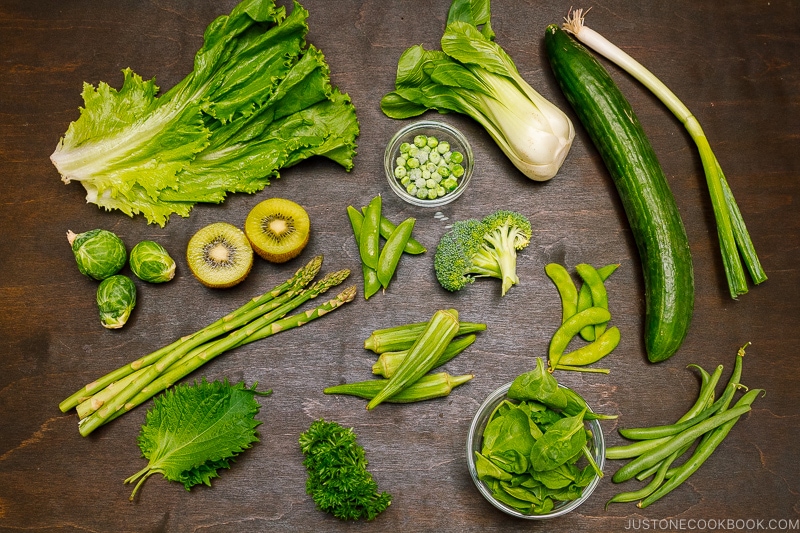
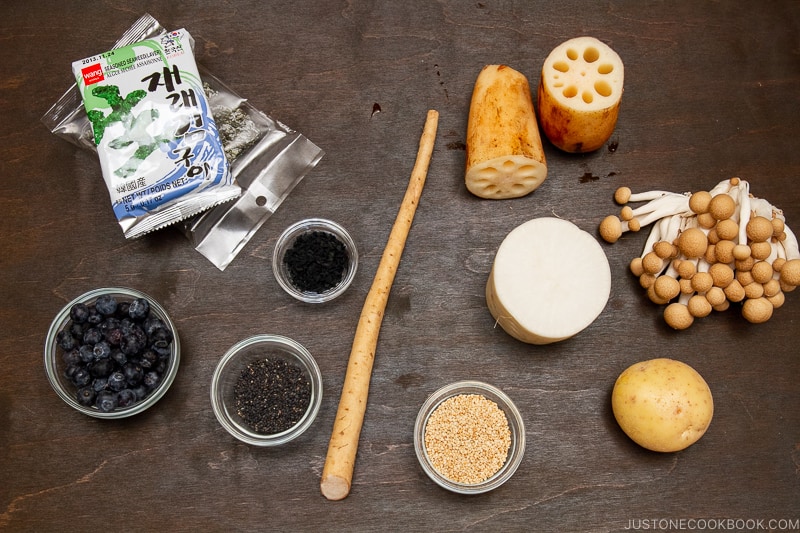
- Red: Tomato, carrot, red radish, bell pepper, apple, grapes, strawberries, plum, raspberries, nectarines, etc.
- Yellow and orange: Corn, sweet potatoes, pumpkin, bell pepper, orange, lemon, banana, etc.
- Green: Lettuce, cucumber, green onion, edamame, broccoli, spinach, okra, shiso, snap peas, asparagus, parsley, bok choy, green beans, Brussels sprouts, green peas, kiwi, etc.
- White, black, and brown: Daikon radish, potato, onion, lotus root, enoki mushroom, white sesame seeds, blueberries, shiitake mushroom, gobo (burdock root), wakame (dried seaweed), nori (dried seaweed sheet), hijiki (dried seaweed), black sesame seeds, etc.
Chapter 3: Meal Prep for Your Bento
Meal prepping can potentially save a lot of time and energy and you can do that with bento-making too. For me, I don’t want to wake up early, so here’s what I do.
Tip #1: Make extra portion (main or side dishes)
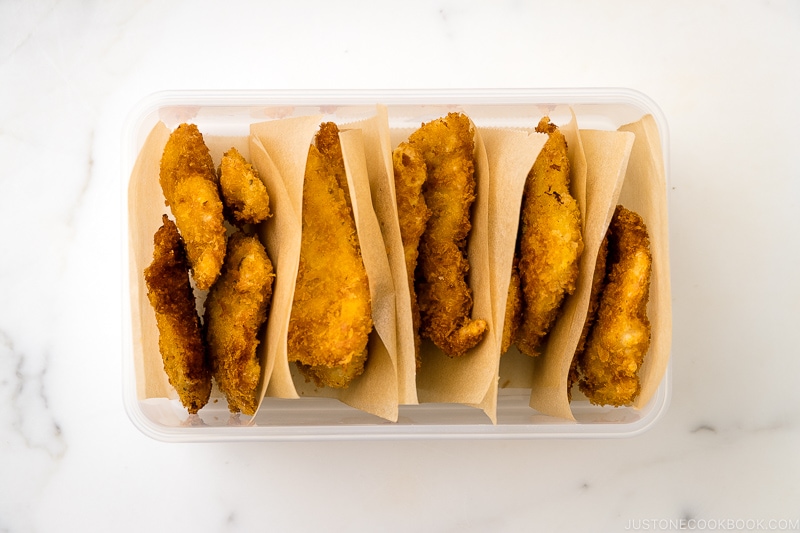
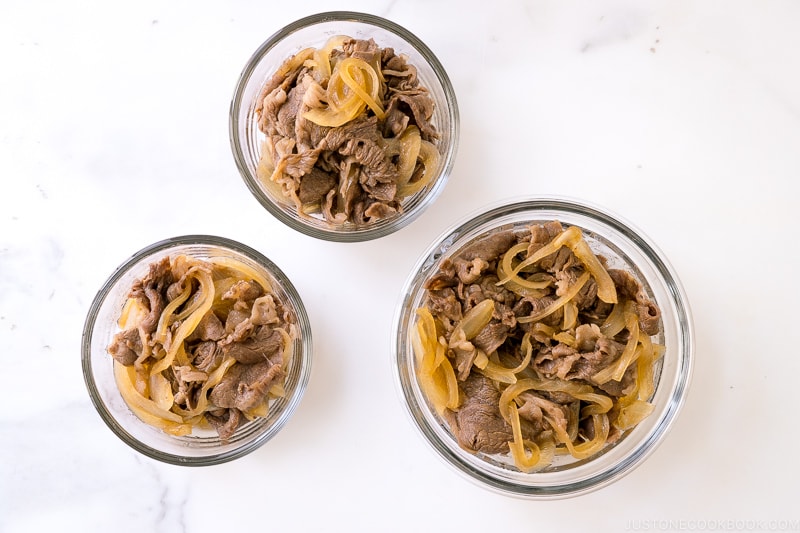
I double up the portion especially when I’m making a freezer-friendly dish for dinner. The extras can be reheated and packed in the bento the next day, OR freeze for later use.
Tip #2: Stock up on bento dishes in the freezer and fridge
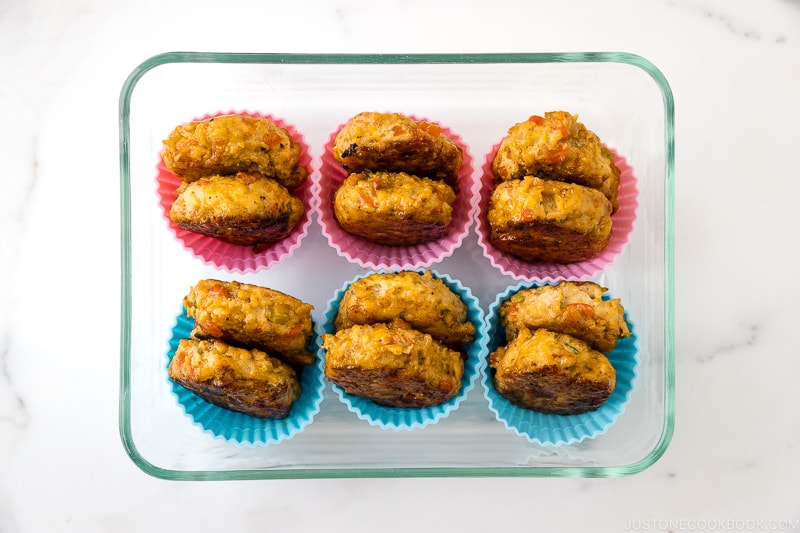
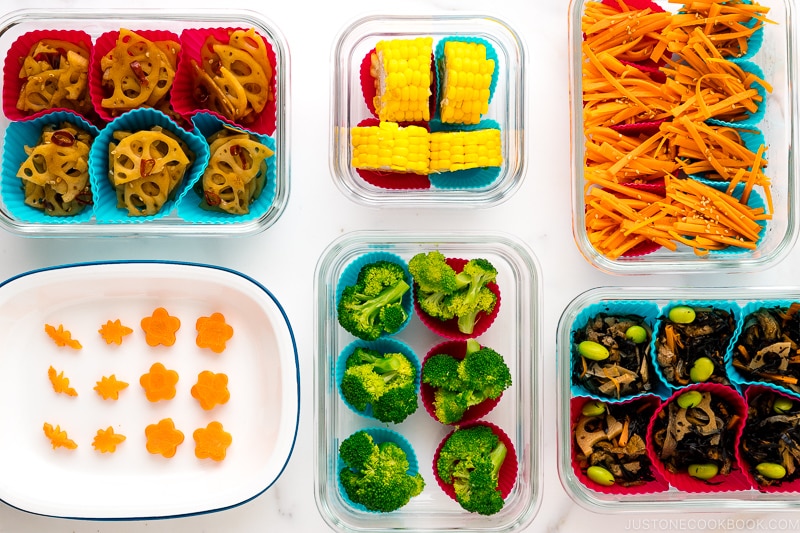
Whenever I have leftovers, I always freeze them and use them in the bento later. And if I have an extra 5 minutes in the kitchen, I blanch vegetables and freeze them (like broccoli), which I will use as bento fillers.
👉🏻 Here is the tutorial on How to Freeze Food for Bento.
- You can purchase these silicone cups and mini ones, and I also use these meal-prep glass containers and love them!
- Make sure to date the container so you can keep track of which food to use sooner. In general, food lasts 2-4 weeks in the freezer.
👉🏻 I have a list of Freezer-Friendly Bento Dishes that you can bookmark. 🔖
If you don’t have a big freezer space, you can also use your fridge to store some of the meal prep-friendly dishes and leftovers.
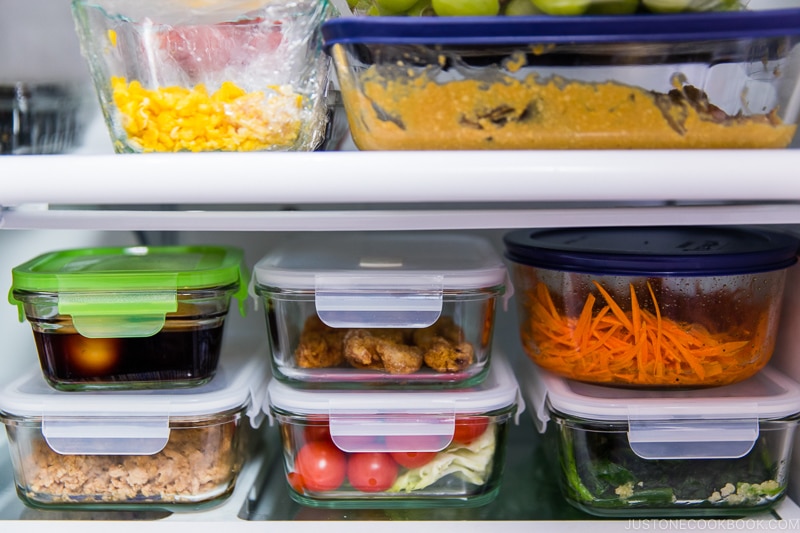
Tip #3: Plan Ahead
I know, for some people including myself, “planning ahead” can be hard. But trust me, planning actually helps you save time and money in the long run, and you will always be more prepared despite the busy schedule.
Allocate 15-30 minutes of your time during the week; figure out what you have in the refrigerator, what you will be cooking throughout the week, and what you will need from the grocery stores.
A friend of mine in Japan uses a meal planner to organize her dinner and bento menus. I adapted hers and made a simplified Bento Calendar. With this calendar, you can visually plan out your weekly dinners and bento menus. If you would like a copy, please click here.
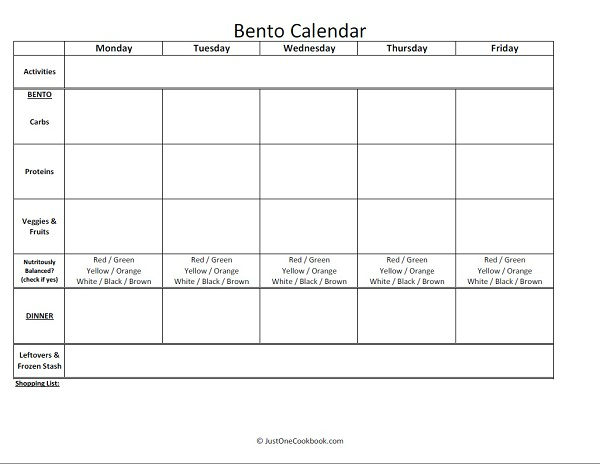
Chapter 4: Pack Bento in the Morning
When you wake up in the morning, here’s what we do:
- Reheat the frozen food and prepare the food you were planning to cook (read Chapter 5 below if you are not sure why we reheat the food).
- Hot food should be packed immediately if you’re using a thermal lunch jar.
- Otherwise, let the hot food cool and then pack it into a non-thermal bento box.
- Add the fillers and do the rainbow color check!
How To Pack Food in the Bento Box
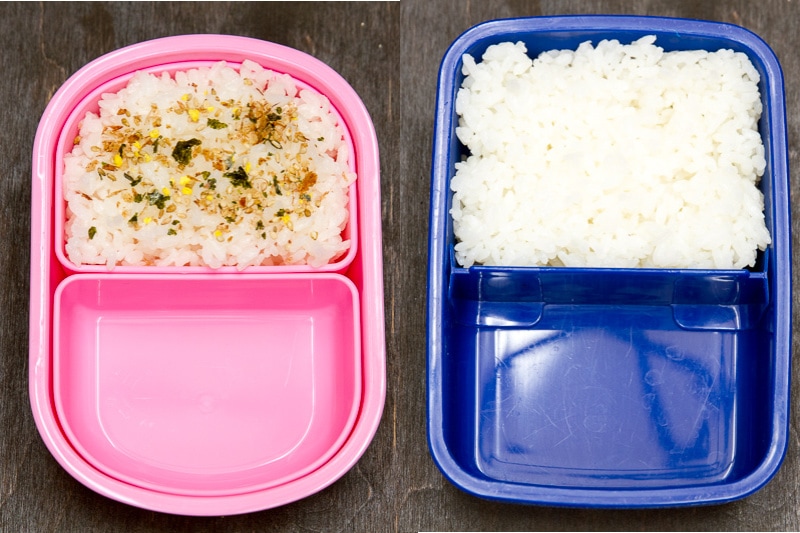
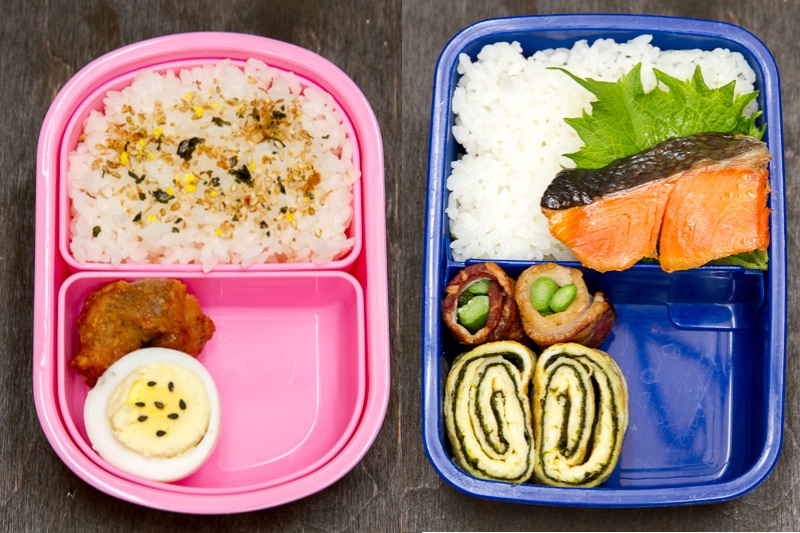
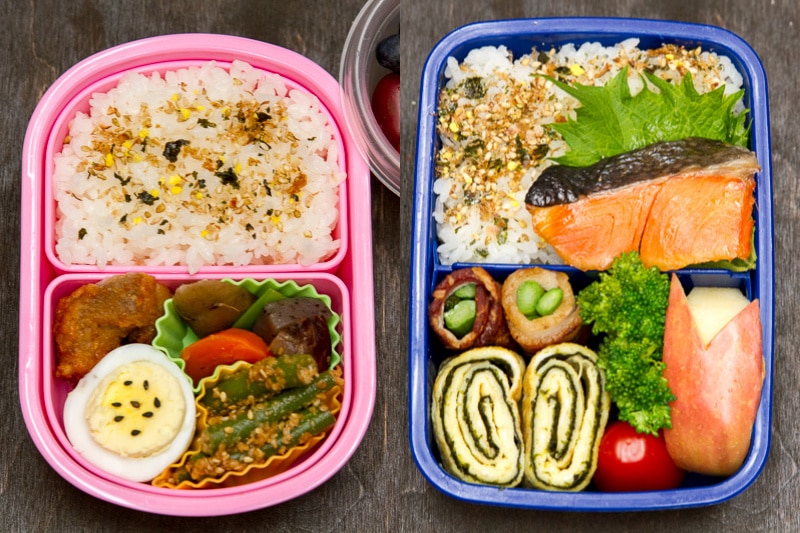
- Put carbs: I usually fill 1/2 of the bento box with carbs. Of course, you can pack brown rice, pasta, wraps, sandwiches, bread, etc instead of white rice.
- Put main dish (protein): Any kind of beef, chicken, pork, tofu, beans, eggs, or other protein sources can be packed in 1/4 of the bento box. If possible, add 2 kinds of protein dishes in the spot.
- Put side dishes (vegetables) and fruits: Vegetables and fruits should be filled up in the remaining 1/4 of the bento box. Packing at least 2 kinds of vegetable dishes is ideal. If you have more vegetable dishes, pack the fruits in a separate container.
Bento Packing Tips
- Pack from big to small dishes: The main dish tends to be bulky, so pack that first in the bento box. Then, add smaller and flexible-shaped side dishes in a silicone cup in the remaining spaces. Any gap can be filled with vegetable “fillers” such as a cherry tomato and blanched broccoli. These fillers prevent the food from shifting inside the box.
- Pack the food tightly: It helps prevent the food from shifting in the bento box. You don’t want to see messy bento when you (or your children) open the bento box at lunchtime. Try packing from bulky food and in the following order.
- Remove cooking liquid: Always drain sauce/dressing before packing it into the bento box. If you like to add some sauce, put it on top of shredded cabbage/lettuce and put food on top to avoid spilling. You can also use a sauce container and pour it at mealtime. Also, the liquid could spoil the food faster, so it’s best for food safety as well.
Watch the Video Tutorial on How to Pack Bento
Chapter 5: Food Safety Tips

Food safety is important when it comes to bento making. Remember to wash your hands and use clean utensils when you handle the food. I highly recommend re-heating the food before packing and cooling down the food completely before closing the bento. And don’t forget to keep ice packs in a lunch bag!
I have a blog post on Food Safety Tips for Bento. And if you’re new to making bento, I highly encourage you to check out this post.
Chapter 6: Final Thoughts
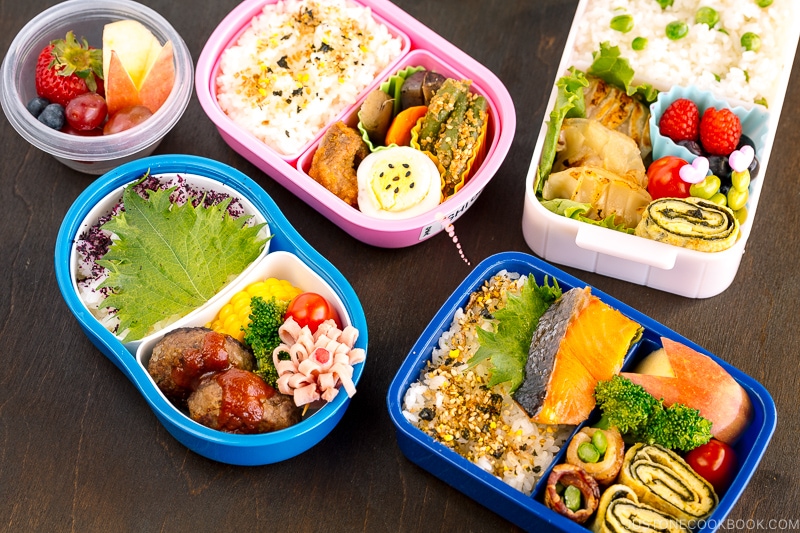
Honestly speaking, packing bento does take longer than packing a sandwich and it’s more work than eating out. Why do we go through extra steps when our life is already busy?
I believe bento is much healthier overall and it’s more economical than eating out. But above all, I want to brighten my children’s day with colorful and cheerful bento. They look forward to their lunchtime, just like how I used to look forward to my mom’s homemade bento. It only requires a little bit of time and effort to make the bento once you get used to making the bento.
I also hope this Japanese bento culture and technique will improve your eating habits to stay healthy and make everyone’s lunchtime more fun. Good luck!
Useful Bento Resources on JOC
Basics
- The Ultimate Guide to Bento Box Lunch
- Food Safety Tips For Bento
- Frequently Asked Questions About Bento – Check this post if your question hasn’t been answered.
Helpful Tips
- How to Pack Bento in 15 Minutes
- How To Freeze Food for Bento
- Meal Prep Freezer-Friendly Bento Dishes
- Meal Prep Bento Recipes Ideas: 3 Dollar Bento Challenge
Menu Ideas
- Bento Menus for Inspiration
- Back to School Easy Bento Box Ideas
- Back to School Easy Bento Ideas & Recipes
- How to Make Cute Bento (Video)
Wish to learn more about Japanese cooking? Sign up for our free newsletter to receive cooking tips & recipe updates! And stay in touch with me on Facebook, Pinterest, YouTube, and Instagram.










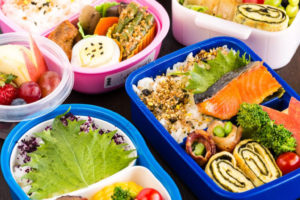
Made my first bento for my husband using this guide last week. Great tips! I’m now going to try to make one once a week. Yay for Bento Thursdays!
Hi Missy! That’s wonderful! I love your Bento Thursdays! I’d love to keep sharing more bento recipes on the blog in the future (even though I make bento everyday for the kids). Your weekly bento decision inspired me! 🙂
This looks great and very healthy, but I’ll never make one. I’m too lazy. If I had a chef, I’d eat this every day and lose 200 pounds.
Hi RockyHeart! Haha, yeah it requires some time to make. Japanese grocery stores sell bento if you live nearby one. 🙂
Do you have any links for some of the bento boxes and where to purchase them. I have a hard time finding them around where I live. Thank you!
Hi Stevie! I know some….
https://en.bentoandco.com/
https://www.bentousa.com/
https://www.lunchaporter.com/en/
I usually bring my own lunch but my food is hard to make into bento because I’m eating low carb style. Would it still be possible to make it into bento style? It’s true that bento always makes the food looks more delicious because of the presentation 🙂
Hi Jos! Sure, I’m pretty sure you can. 🙂 I’m not sure what type of foods you normally eat (or would like to pack), but use a bento box with dividers or silicone mold to make a few divisions so everything won’t mixed up. Tightly pack is another trick so you won’t be disappointed when you open the bento at lunch (and see everything mixed up). 🙂
Hi Nami-san,
As for my low carb food, for sure the ratio would be veggies | protein | carb 4: 2: 1 LOL..it’s a total opposite of the traditional Japanese bento which majority of the food group is carb 😀
Hi Jos! Yes, the rice gets the biggest part in bento usually. 🙂
thank you for these ideas. My youngest daughter and I saw a show about bento and she was very excited. She wants bento box lunches for school now. She has only been interested in sandwiches until now.
Hi Fawn! Thank you for reading my post! Hope you enjoy making bento for your daughter! 🙂
I have a question about the rice. I make a bento the night before and then went on a picnic the next day. How do I make sure the rice isn’t hard? The same for onigiri? Thank you!
Hi Veronica! Rice always gets hard when you put in the refrigerator. One tip I can suggest is to wrap with towels so the bento doesn’t get too cold but still safe temperature for food. Same for Onigiri. I always heat up rice in the morning and then pack… 🙂
Can I put Curry and rice in the carbs section? And can I pour the curry on top of the rice before I go to school?
Hi ユスラー! You definitely can. If you prefer to eat hot or warm curry, you might need to consider the option of putting curry rice. Can you microwave before eating? Does your thermo keep the food warm enough (if not microwaving the food) etc. Some Japanese pack curry rice for lunch, but sometimes depending on fat content of the curry, it might become solidified and you may want to microwave so it becomes nice sauce instead of solid. So it really depends how you bring the bento and how you heat it. For example, my curry loving kids prefer not to bring curry to school because their thermo can’t keep it hot or warm enough till their lunch time. I hope this helps!
Hi, I’ve just got to find your website and it’s amazing;beautiful pictures,good and step by step recipes.
Hi Sera! Thank you! I hope you enjoy cooking from my recipes. 🙂
Hi there Nami,
I’d like to thank you for this wonderful post. I’m really having a hard time on making my sister eat healthy foods and perhaps I should consider making her Bento everyday. I am pretty sure this will work for her. Thank you again!
Hi Gean! Thank you for reading this post! Bento is a wonderful way to control the portion of food and to see what goes into the meal as you see everything in the little box. More conscious about what goes into the box. 🙂 Hope your sister will enjoy your bento! 🙂
Hi,
loving your share!!!
I’m from Singapore and I learning prepare lunch box for my children. our culture love to eat foods hot.
can I put my prepared bento in thermal lunch bag instead of keep it cold?
if ok to keep the food in thermal bag to keep warm, when should I pack my food in lunch box (warm or hot)?
thanks in advance.
Thank you Lynette! You can use thermal lunch jar, BUT my children always say the food is lukewarm or “warm” instead of hot in the jar. I guess that’s the best I could do as I prepare in the morning before they go to school. I put hot water in the jar right before I put hot food, too, but it just doesn’t keep hot that long… 🙂
Wow! This is so helpful! I’ve been wanting to prepare my own lunches to save time and money (so I don’t have to get take-out at work) and this system you have looks very good! I’m going to try this for myself! ^-^
May I ask you a question about bento boxes? I was thinking of getting either a steel or wooden one for myself (I don’t like plastic), but was concerned about how they wear over time. Do you have any insights about this? Have you used a wooden bento box? Or steel? Please let me know what you think, as I don’t have any experience with bento boxes, so I really don’t know which would be better.
Thank you very much! ^-^
HI Oleander! If you don’t like plastic, then I’d use stainless steel one like LunchBots. You can wash in a dishwasher too! 🙂
http://www.lunchbots.com/
I have a question regarding the Packing of the bento boxes, say my boxes do not have sections it is just stackable “single serve” how would I pack these.. for example should I pack the “hot”/ “room temp” foods on the bottom and “cold” foods on top or vice versa. thanks..
Hi Angela! Yes, I recommend to separate cold items from warm ones. Ideally, you want to pack into the bento when the food is cooler – you can put the hot food in silicone mold, and keep it out until it cools down (plus, cool faster). I still keep it far away from the cold food. In between, you can put cherry tomatoes, steamed broccoli, or something that doesn’t go bad by the heat. Hope this helps!
Good evening. I just came across this site. I love how you prepare the bento lunch boxes! I am new to this and was wondering where you purchased your bento box listed in the photos with the coordinating dividers as well as the accessories. I have a 4 year old little girl who will be going to pre-k in August and I am adamant about learning on how to prepare these delicious meals for her. Do you have toddler friendly recipes that do not contain any sort of nuts? Her school does not allow me to pack her any nuts, hot dogs, grapes.
Desperately seeking advise and directions on how to begin this journey.
Hi Aimee! Welcome to my blog! I hope your daughter will enjoy bringing bento box! Most of my recipes don’t include nuts and I hope you find some recipes for making bento! Will continue making and sharing bento recipes in the future. 🙂
Can I ask during the cooling down of food, do I leave it fully or partially exposed to air?
Hi Elaine! It depends – If I leave it out for a longer time, I usually cover half way and let it cool. I don’t want other foods to be dried out so that’s why I cover partially. However, I always remove the condensation from the lid before closing. Depending on your food/menu in the bento, you can remove the lid completely and let it cool down. 🙂
Hey Nami, this is really cool. I’ve always wanted to know how to make one of these mostly for myself though I can share this with my family. This is helpful to me so now I can make one of these for my niece. Thanks so much for sharing this.
Hi Jess! I’m so glad to hear this post was helpful! Thank you for reading my blog, and good luck with making bento! 🙂